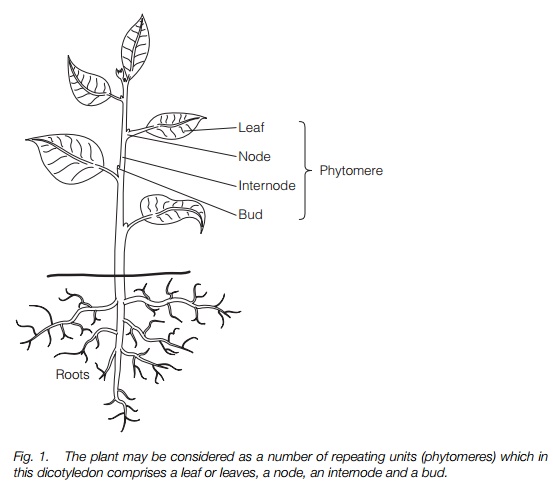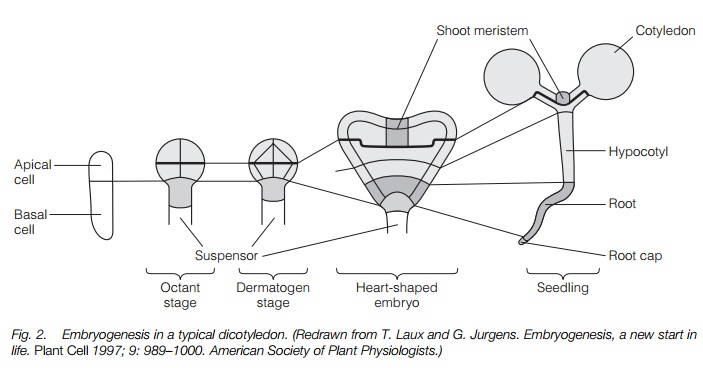Chapter: Plant Biology : Growth and development
Features of Plant growth and development
FEATURES OF GROWTH AND DEVELOPMENT
Key Notes
Growth and development
Growth involves cell division followed by cell enlargement. Primary meristems produce files of cells in concentric rings, which form the major tissues of the plant. Development occurs when cells and tissues change form and function to give the organs and structures required during the life cycle of a plant. Growth originates with new cells formed by meristems.
Cell growth
Cell growth occurs when the cell wall is made plastic by enzymes. The driving force for cell expansion is turgor pressure, which pushes the plasma membrane out against the cell wall. The direction of growth is governed by the orientation of cellulose fibers in the wall.
Embryogenesis
The fertilized ovule first divides to give an apical and a basal cell. The basal cell forms the suspensor and the root cap; the apical cell gives the root, shoot and cotyledons of the seedling. Cell lineages can be traced from the seedling through the various stages of cell division, the octant stage, the dermatogen stage and the heart-shaped embryo.
Development of tissues
The cells laid down in the meristem form all the tissues of the plant. The first stage of development is determination, in which the cell becomes established on a pathway of change. The cell then becomes differentiated to its new function. Determination and differentiation involve altered gene expression.
Tissue culture and totipotency
In tissue culture, tissue explants are de-differentiated to form a callus and then redifferentiated by varying hormone or other growth conditions. Single cells in culture can be shown to be totipotent as they can regenerate to form an entire plant.
Cell-to-cell communication
Cell-to-cell communication occurs through plasmodesmata connecting rows or blocks of cells symplastically.
Plant and animal development compared
Cell walls prevent cell movements that are characteristic of animal development. Plant embryonic tissue is maintained through the life of the plant, whereas animals have a distinct embryonic stage. This gives greater plasticity of plant development. Plant cells show totipotency, the ability for single cells to regenerate an entire organism.
Growth and development
Growth occurs when new cells and tissues are formed by cell division (Topic B6) followed by cell enlargement. Development is the process whereby those cells change form and function to form the specialized tissues, organs and structures required during the life cycle of a plant. It commences with the first cell division after fertilization of the ovule and continues through seed development, seed germination, the development of the seedling to the mature plant, flowering and production of the next generation of ovules. It also includes the processes of cell death and plant senescence.
Plant growth is accretionary, new cells being constantly added in meristems (Topic C1), regions that essentially remain embryonicthroughout the life of the plant. Plant growth begins with cell division. Cell enlargement and change in form and function follows subsequently. In the meristem, dividing cells surround the quiescent center where no cell divisions occur. As the new cells are surrounded by a cell wall, migration of cells to new locations is impossible. Therefore, the rows (or files) of cells formed (usually in concentric rings) predict the future tissues of the root or shoot. As primary growth occurs by the formation of new tissues at growing tips, different cells and tissues in the same plant are of different ages. The growth of a herbaceous dicotyledon may be considered to occur as successive phytomeres consisting of stem, bud and a leaf (Fig. 1).
Cell growth
Cell growth in plants can only occur when the cell wall (Topic B2) is made plastic by the action of enzymes that break the cellulose cross-linkages. The direction of cell expansion is governed by the orientation of the major fibers (cellulose fibrils) within the wall. The driving force for cell expansion is turgor pressure, which pushes the plasma membrane out against the cell wall. Cell growth largely occurs separately from cell division.

Embryogenesis
The basic plan of the plant is established soon after the ovule is fertilized, in the early stages of the development of the embryo (embryogenesis) in the formation of the seed. Embryogenesis in arabidopsis, a dicot, is shown in Fig. 2. The fertilized ovule divides to give two cells: the apical cell and the basal cell. The basal cell forms the suspensor, connecting the embryo to maternal tissue and also the root cap meristem. The apical cell undergoes many cell divisions. The first stage is the octant stage (named from the eight cells in two tiers formed). This is followed by the dermatogen stage (where tangential cell divisions have occurred creating tissue layers). Finally the heart-shapedembryo is formed. This contains the origins of all the major structures of the seedling. The lobes of the heart shape are the cotyledons; between them lies the shoot meristem. The center of the heart forms the hypocotyl and the lower layers form the root. As plant cells cannot migrate during development, it is possible to trace cell lineages back to the dermatogen and octant stages. These lineages are illustrated in Fig. 2.

Development of tissues
The concentric rings of cells laid down in meristems are initially similar in form: non vacuolate, isodiametric (roughly cuboid) and with thin cell walls. Subsequently they form all the tissues of the plant. This involves stages during which major changes in gene expression occur. The initial stage of this process is determination, in which the cell becomes established on a pathway of change but physical changes are not yet detectable. At this stage, the cell is committed to a pathway of development. The cell then becomesdifferentiated to its new function, losing some characteristics and gaining others. In plants, both determination and differentiation are frequently reversible given suitable treatments. A major question about development and differentiation is: what causes them altered gene expression that results in ordered patterns of differentiated tissue?
The position of the cell is likely to be important and endogenous chemical signals within the tissue are involved (Topics F2 and F3).
Tissue culture and totipotency
Plant tissue may be cultured in either liquid or solid media containing an energy source (sucrose), plant hormones (auxins and cytokinins; Topic F2) and a range of other minor components. In tissue culture, tissue explants (small pieces of plant) are first de-differentiated to form callus, an amorphous mass of cells, and then re-differentiated to form roots, shoots and other organs by varying hormone or other growth conditions. In suspension cultures, it has been shown that single cells can regenerate to form an entire plant, going through all the normal stages of embryo development. As the parent cell did not originate from reproductive cells it demonstrated that plants show totipotency – the ability for a differentiated cell to retain all the genetic material in a form required to form
an entire organism.
Cell-to-cell communication
While plant plasma membranes are separated by the presence of the cell wall, cell-to-cell contact is made by plasmodesmata (Topic B2). Rows or blocks of cells are therefore connected as if in colonies. Macromolecules such as RNA and smaller signalling molecules can move between cells.
Plant and animal development compared
●Plant cells are not mobile during development due to a cell wall.
●In animals, determination and differentiation occurs in the embryo. In plants, cells in the meristems keep dividing and the newly formed cells keep differentiating throughout the life of the plant. This means that different parts of
the same plant are of different ages.
●Determination and differentiation of plant cells is much more plastic than animals. Application of hormones, wounding or other treatments result in plant cells altering pathways of development to form different tissues and
organs.
●Plant cells are totipotent (in other words a single, non germ-line cell can be induced to regenerate to a whole organism), a property not generally seen in animals. This implies that the entire genome of that cell is intact and functional and that it can be brought back to an embryonic state.
●In spite of the cellulose cell wall, plant cells may communicate via plasma desmata.
Related Topics